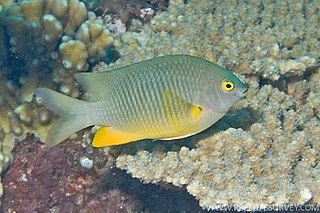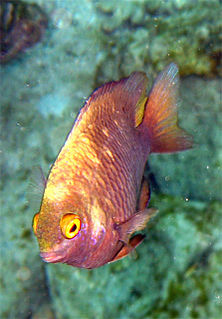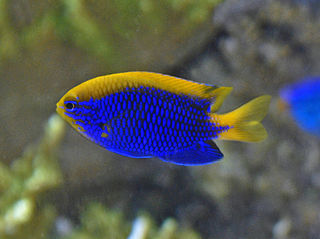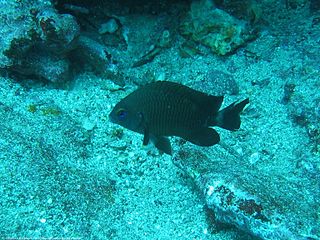
Pomacentridae is a family of ray-finned fish, comprising the damselfishes and clownfishes. This family were formerly placed in the order Perciformes but are now regarded as being incertae sedis in the subseries Ovalentaria in the clade Percomorpha. They are primarily marine, while a few species inhabit freshwater and brackish environments. They are noted for their hardy constitutions and territoriality. Many are brightly colored, so they are popular in aquaria.

Ostorhinchus fleurieu is a species of cardinalfish native to the Red Sea and Persian Gulf, the Gulf of Oman, and the waters around East Africa, Seychelles, India, Sri Lanka, the Indo-Malayan region, and Hong Kong., south to the Ashmore Reef, Western Australia. It is the type species of the genus Ostorhinchus. The specific name honours the French explorer and hydrographer Charles Pierre Claret, comte de Fleurieu (1738-1810) who was a colleague and friend of Lacepède's.

The Coral Sea gregory, Stegastes gascoynei, is a damselfish of the family Pomacentridae in the western Pacific Ocean at depths between 1 and 30 m. Its length is up to 15 cm. The specific name commemorates the Royal Australian Navy River-class frigate HMAS Gascoyne, from which the type specimen was collected.

Chrysiptera hemicyanea, known commonly as the azure damselfish, azure demoiselle, half-blue demoiselle, and yellow-dipped damsel, is a species of damselfish.

Pomacentrus smithi, Smith's damselfish, is a species of damselfish from the family Pomacentridae which is found in the Western Central Pacific. It occasionally makes its way into the aquarium trade. It grows to a size of 7 cm in length. The specific name honours the American ichthyologist Hugh McCormick Smith (1865-1941).

Chrysiptera springeri is a species of damselfish known by the common name Springer's demoiselle.

Chrysiptera starcki is a species of damselfish known by the common name Starck's demoiselle. It is native to the western Pacific Ocean, where it has been reported from the Ryukyu Islands and Taiwan to Australia, New Caledonia, and Tonga. It was originally described in 1973 as Abudefduf starcki.

Istiblennius dussumieri, the streaky rockskipper, is a species of combtooth blenny found in coral reefs in the western Pacific and Indian Oceans. It is also commonly known as the Dussumier's rockskipper, streaky dussumier, or the Dussumier's blenny.

Ophioblennius steindachneri, the large-banded blenny or the Panamic fanged blenny, is a species of combtooth blenny found in coral reefs in the eastern Pacific ocean. This species reaches a length of 18 centimetres (7.1 in) SL.
Labrisomus wigginsi, the Baja blenny, is a species of labrisomid blenny endemic to the Pacific coast of Baja California. This species is only known from shallow, weed-grown rocky areas and also from tide pools where it is known to occur down to a depth of about 9 metres (30 ft). The specific name honours the collector of the type, the botanist Ira L. Wiggins (1899-1987) of Stanford University.
Norfolkia thomasi, known commonly as the Thomas' triplefin, is a species of triplefin blenny in the genus Norfolkia. It was described by Gilbert Percy Whitley in 1964, naming it in honour of Leonard Rees Thomas who organised the Australian Museum's 1962 Swain Reefs Expedition. The hemispherical eggs of the Thomas' triplefin are covered in sticky threads that help anchor them in the algae on their nesting sites. This adaption helps insure the safety of the eggs. One the eggs hatch the larvae that emerge are planktonic and they stick to shallow waters near the shore. The matured Thomas' triplefin then ventures out into the coral reef and intertidal pools. This species is found in the western Pacific Ocean from the Ryukyu Islands to the Tuamoto Archipelago, in Australia it is distributed from the northern Great Barrier Reef south to Byron Bay, New South Wales.

Stegastes beebei, is a species of damselfish found on coral and rocky reefs at depths between 0 and 15 m. They are somewhat territorial, and chase away small intruders. They are omnivorous, grazing on algae and nibbling at small crustaceans and the tentacles of anemones. They are oviparous, with distinct pairing during breeding. The eggs are demersal and adhere to the substrate. Males guard and aerate the eggs.

Abudefduf troschelii, the Pacific sergeant major or Panama sergeant major, is a species of damselfish belonging to the family Pomacentridae that can be identified by the pronounced black stripes on the lateral sides of the fish. Its specific name honors the zoologist Franz Hermann Troschel (1810-1882). It is native to the neritic pelagic zone of the shallow water coral reefs in the Eastern Pacific Ocean and they are an omnivorous species feeding on plankton and algae attached to their coral habitat. Abudefduf troschelii is a sister-species of A. saxatilis but have diverged from each other since the uplift of the isthmus of Panama, separated by the rise of the Panama land bridge 3.1 to 3.5 million years ago. Males, like in many other marine species, take care of and defend newborn A. troschelii after they have been hatched by eggs from the female. There are currently no major threats to the species and there is no indication of a current decline in its population size. The IUCN Red List lists this damselfish as being of “least concern”.
Neoglyphidodon carlsoni is a species of damselfish in the family Pomacentridae. It is found in the western and central Pacific Ocean. Adults can grow up to a maximum length of 10 centimetres (3.9 in) This fish is omnivourous. Occasionally, they are found in the aquarium trade.

Chrysiptera brownriggii, commonly known as the surge damselfish, is a marine fish widespread in Indo-Pacific waters from East Africa to the Marquesas Islands and Society Islands, north to Japan and south to Australia. Its common name arises because it is associated with the rubble in channels created by tidal surges in reefs, but it is also found on reef flats and submerged terraces. It is territorial but is frequently encountered in groups. The identity of the person honoured by the specific name was not stated by Bennett in his original description but it is almost certainly Robert Brownrigg (1759-1833) who was governor of Ceylon where the type was collected.

Dascyllus strasburgi, Strasburg's dascyllus, is a species of ray-finned fish from the family Pomacentridae, the clownfishes and damselfishes. It is endemic to the Marquesas Islands where they are found among coral and rocky reefs. and feed on zooplankton. The specific name honours Donald W. Strasburg of the University of Hawaii, a fish ecologist and collector of the type specimen.
Microspathodon frontatus, is a species of ray-finned fish from the family Pomacentridae, the clownfishes and damselfishes. It is found in the eastern Atlantic Ocean off west Africa in the Gulf of Guinea as far north as Ghana as well as the islands of Bioko and Sao Tomé and Principe where it is abundant. It is found among rocky reefs, rocks and rubble. Like other damselfish this species forms pairs for breeding, the eggs stick to the substrate and are guarded and aerated by the males.
Jordan's damsel is a species of ray-finned fish from the family Pomacentridae, the damselfishes and clownfishes, it is the only species in the monotypic genus Teixeirichthys. It has a disjunct distribution in the Indian and western pacific Oceans having been recorded from the Red Sea, Mozambique Channel, Seychelles, Taiwan, Hong Kong, China and Japan. It is found in beds of sea grass and over sandy substrates. Jordan's damsel is frequently observed to form mid-water aggregations of as many as several hundreds of individuals. It occurs at depths of 10–20 metres (33–66 ft). It has been recorded using small rocky outcrops and areas of debris to nest in in the Gulf of Aqaba. The generic name honours Gabriel M. Teixeira (1897-1973), who was the Governor-General of Mozambique and who assisted J.L.B. Smith's studies of the fish fauna of that territory. The specific name and common name both honour the American ichthyologist David Starr Jordan (1851-1931) who gave a collection of specimens from Swatow to Rutter, among which was the type of this species.

Lepadichthys frenatus, the bridled clingfish, is a species of clingfish from the family Gobiesocidae. It is found on shallow reefs in the western Pacific Ocean.
Atherion elymus, the bearded silverside or pickleface hardyhead, is a species of silverside from the family Atherionidae. It is found in the western Pacific Ocean.















